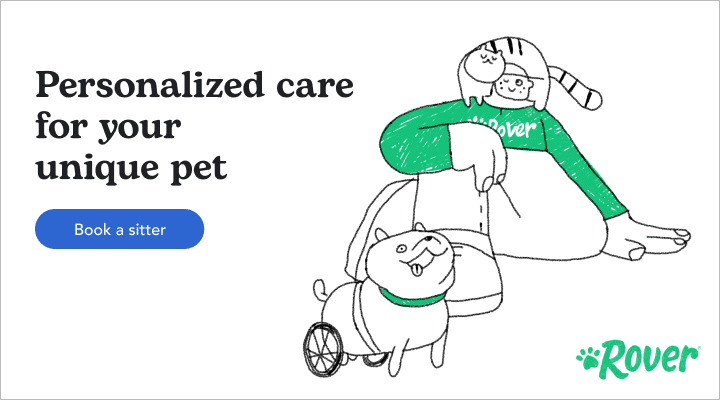- This post contains affiliate links. Read more here.
- Not a substitute for professional veterinary help.
“Hooray for Halloween!” said no dog ever. Between the strange costumes, the constant ring of the doorbell, and the temptation to consume oodles of deadly candy, Halloween is not ideal for most dogs. I’ve heard many dog owners say, “my dog hates Halloween.” And even if your dog doesn’t mind dressing up, it’s still probably not your dog’s favorite holiday, all told.
Help! My Dog Hates Halloween
Here are our top three reasons your dog may hate Halloween, and how to help them cope.
People in costume are scary
Dogs are not good with unpredictability or novelty. To them, humans come in only a small varied assortment that generally (but not always) includes two arms, two legs and an upright body. This is why dogs who have not been socialized to people with disabilities can have trouble accepting that humans also come with wheelchairs, canes, or other devices to help them access the world.
Dogs don’t care about ghosts or goblins, but they do care about the outline or shape a costume creates.
On Halloween, humans suddenly become different. Dogs don’t care about ghosts or goblins, but they do care about the outline or shape a costume creates. Wings, hats, or other accessories that protrude from the body can turn a human into a monster of unfamiliar proportions. Face-covering masks can be terrifying from a canine perspective.
Help your dog by simply avoiding costumed people, if you can. That means it’s not a great idea to take your dog to the local Halloween fest. If you’re going to wear a costume for the evening, try changing into it where your dog can’t see you.
Not every dog is comfortable in a costume
Putting a costume on your dog may seem like the most adorable thing that has ever happened, but it’s not for every dog. Many dogs just aren’t feeling that minion outfit or superhero cape.
If you can’t resist putting your dog in a Halloween costume, look for one that fits more or less like a simple sweater without dragging pieces, noisy bits, or tight accessories for the head, tail or paws. Introduce your dog to their costume slowly, rewarding them with treats for allowing you to bring it close to their body, for slipping their head through and, ultimately, for putting it on them.
As you do so, look for signs of discomfort or anxiety. Does your dog freeze when the costume is on? Do they try to shimmy out of it or rub it off against furniture? If so, a simple seasonal bandana or collar may be the perfect compromise.
Halloween candy isn’t safe for dogs
The problem with chocolate is a compound called theobromine, which is toxic to dogs (and other pets). It only takes about an ounce per pound of bodyweight to kill a dog, and your average candy bar weighs two to three ounces. That means that just three candy bars can kill a ten-pound dog. Even smaller doses will make a dog sick, causing symptoms like vomiting and diarrhea. In larger quantities, muscle tremors, seizures, internal bleeding or heart distress are possible.
Always keep Halloween candy locked away somewhere your dog can’t access it. If they do, call your vet immediately. If you aren’t sure if the empty candy bar wrappers belong to your dog, look for signs of hyperactivity— a symptom that typically precedes theobromine poisoning.
What to do instead
Even though you may want your dog to join in the festivities, they are likely to be happier out of the fray.
That might mean booking a trusted pet sitter they can hang out with while you go out. It could also mean simply tucking them into a cozy, dog-safe room out of the way of trick-or-treaters and partygoers.
Chances are, your dog will be thrilled to chill out with soothing white noise or classical music playing, a KONG stuffed with dog-friendly goodies, and a cozy bed to snuggle in.

